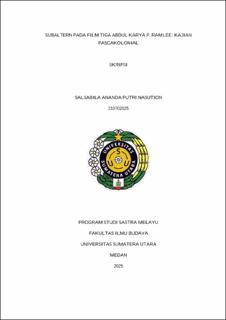Subaltern pada Film Tiga Abdul karya P. Ramlee: Kajian Pascakolonial
The Subaltern in P. Ramlee’s Film Tiga Abdul: A Postcolonial Perspective

Date
2025Author
Nasution, Salsabila Ananda Putri Nasution
Advisor(s)
Nasution, Arie Azhari
Metadata
Show full item recordAbstract
This study discusses the intrinsic elements and the construction of the subaltern in the film Tiga Abdul by P. Ramlee. The intrinsic elements analyzed include the theme, setting, plot, characters/characterization, point of view, and moral message found in the film Tiga Abdul. The construction of the subaltern focuses on the characters' acts of colonization, negotiation, and dismantling of the colonizers' power. The research method used is descriptive qualitative, with the data source being the film Tiga Abdul by P. Ramlee. Data collection was carried out using literature study techniques, and the data presentation in this research is displayed in forms such as tables, images, diagrams, and narrative explanations. The research findings show that the intrinsic elements in Tiga Abdul include the theme of wealth, brotherhood, and family values. There are eleven settings of place in the film: the Kingdom of Isketambola, the office of Ismet Ulam Raja, Abdul Wahab’s bird shop, Abdul Wahib’s carving shop, Abdul Wahub’s music shop, Ismet Ulam Raja’s house, Sadiq Segaraga’s antique store, the market, Sulaiman Akhlaken’s office, and the horse stable. There are two temporal settings: day and night. The five socio-cultural settings identified are: greeting with salam when meeting, a nation of traders, handshaking culture, human trafficking, and Middle Eastern-style clothing and appearance. The film Tiga Abdul by P. Ramlee uses a progressive (linear) plot and features sixteen characters, including protagonists, antagonists, and supporting roles. The point of view used in the film is third-person, with the moral message being: be kind-hearted, honest, fair, and trustworthy; avoid greed and vengeance, as they lead to destruction; and be forgiving and willing to reconcile. The construction of the subaltern in Tiga Abdul involves themes of injustice, slander, and threats. The subaltern characters engage in negotiation and resistance against colonial power by: severing family ties, dismantling the dominance of the colonizers, reconstructing hegemony and domination, and granting freedom to subaltern subjects.
Collections
- Undergraduate Theses [222]
